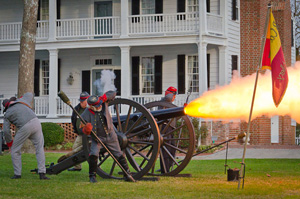
 Washington Visitor Center
Washington Visitor Center
102 Stewart Parkway, Washington, NC 27889
Open 7 days a week: 10 am - 4 pm
To receive visitor information by telephone, call us at 1-800-546-0162
The scars of the Civil War are still visible in Washington NC. Crossing the Pamlico River on Highway 17 look off to the west and you will see the remains of the Union Army's ship,Picket, jutting from the Tar River where it blew up on September 6th, 1862. Driving down Main St. you will view houses with dates of construction in the 1850's 60's and 70s', testimony to the fact that the town was burnt by Union troops during their evacuation after the fall of Plymouth, NC. Even more startling are the two houses on Water Street which were built in 1780 and 1795. They stood through the fires and barrages of the war, having cannon balls imbedded in their walls, a bequest of the shelling of the town by the Rebel troops located on the southern shore of the Pamlico River.

Port O' Plymouth Museum
Washington County Historical Society
302 East Water St, Plymouth, NC 27962 - Phone: 252-793-1377
Open Tuesday thru Saturday from 9am to 4pm
Website: http://www.livinghistoryweekend.com/index.html
E-mail: headquarters@livinghistoryweekend.com

Albemarle Sound (Edenton Harbor)
Edenton-Chowan County Tourism Development Authority
116 East King Street, Edenton NC 27932
252-482-3400 / 800-775-0111
Email: nancy.nicholls@chowan.nc.gov
Civil War Markers located in town include the Chowan River/Buffalo and how the river became a boundary between Federal and Confederate territories. Edenton/Battle of the Albemarle Sound on Edenton Harbor - the battle between the CSS Albemarle and a Union flotilla on May 5, 1864. The Edenton Bell Battery, an artillery unit organized locally using guns cast from the bells of churches and municipal buildings.
Visit the Historic Edenton State Historic Site Visitor Center to learn about the Harriet Jacobs' escape from slavery via the Maritime Underground Railroad and her Reconstruction relief work.
Albemarle Sound
Washington, NC - April 19, 1863
The Battle of Washington took place from March 30 to April 19, 1863, in Beaufort County, North Carolina, as part of Confederate Lt. Gen. James Longstreet's Tidewater operations during the American Civil War. This battle is sometimes referred to as the Siege of Little Washington
Following the Confederate victory at Fredericksburg, General Robert E. Lee felt confident enough to dispatch a large portion of his army to deal with Union occupation forces along the coast. The whole force was put under the command of Lt. Gen. James Longstreet. While Longstreet personally operated against Suffolk, Maj. Gen. D. H. Hill led a column which moved against Federal garrisons at New Berne and Washington, North Carolina.
Union Maj. Gen. John G. Foster, commanding the Department of North Carolina, was responsible for the overall defense of the Union garrisons along the North Carolina coast. After Hill's attack against New Berne failed, Foster arrived in Washington to take personal command of the garrison. A West Point trained Army engineer, put his skills to good use improving the town's defenses as well as employing the use of three gunboats in the defense. By March 30, the town was ringed with fortifications and Brig. Gen. Richard B. Garnett's brigade began the investment of Washington. Meanwhile Hill established batteries as well as river obstructions along of the Tar River to impede reinforcements. He also posted two brigades south of Washington to guard for any relief efforts coming overland from New Bern. The Confederates sent a reply to Foster demanding surrender. Foster replied saying "If the Confederates want Washington, come and get it." Thus the engagement devolved into one of artillery and even so the Confederates limited their bombings to conserve their ammunition. In time both sides were running low on supplies and conditions grew miserable in the rain and mud. Despite the lack of progress against Washington, Hill was accomplishing a vital objective in the form of foraging parties, so long as the Federals were pinned down.
Foster decided that he would escape Washington and personally lead the relief effort, leaving his chief-of-staff, Brig. Gen. Edward E. Potter in command at Washington. On April 13, the USS Escort braved the Confederate batteries and made its way into Washington. The Escort delivered supplies and reinforcements in the form of a Rhode Island regiment. It was aboard this ship on April 15 that Foster made his escape. The ship was badly damaged and the pilot mortally wounded but Foster made it out.
About the same time Foster made an escape, Hill was faced with numerous reasons that ultimately led to his withdrawal: the completion of his foraging efforts, Union supplies reaching the Federal garrison and finally a message arrived from Longstreet requesting reinforcements for an assault on Suffolk. Hill broke off the siege on April 15 and began to withdraw Garnett's brigade fronting Washington's defenses.On April 19. Foster had made it back to New Bern and immediately began organizing a relief effort and by April 20 the Confederates had completely withdrawn from the area. Apart from raids conducted by Foster and Potter, North Carolina remained relatively quiet until 1864 when Robert E. Lee was able to spare troops for another operation against Federal control posts on along the coast.
Plymouth, NC - April 17, 1864
see also Ironclads on CSS Albemarle and CSS Neuse)The Battle of Plymouth is a Confederate attack on Plymouth, North Carolina, in an attempt to recapture ports lost to the Union two years before. The four-day battle ended with the fall of Plymouth, but the Yankees kept the city bottled up with a flotilla on nearby Albemarle Sound.
In 1862, the Union captured Plymouth and several other points along the North Carolina coast. In doing so, they deprived the Confederacy of several ports for blockade-runners and the agricultural products from several fertile counties. In the spring of 1864, the Confederates mounted a campaign to reverse these defeats. General George Pickett led a division to the area and launched a failed attack on New Bern in February. Now, General Robert Hoke assumed command and moved his army against Plymouth, fifty miles north of New Bern. He planned an attack using the C.S.S. Albemarle, an ironclad that was still being built on the Roanoke River inland from Plymouth.
With 7,000 men, Hoke attacked the 2,800-man Union garrison at Plymouth on April 17. His troops began to capture some of the outer defenses, but he needed the Albemarle to bomb the city from the river. The ironclad moved from its makeshift shipyard on April 17, but it was still under construction. With workers aboard, Captain James Cooke moved down the Roanoke. The Albemarle's rudder broke and the engine stalled, so it took two days to reach Plymouth. When it arrived, the Rebel ship took on two Yankee ships, sinking one and forcing the other to retreat. With the ironclad on the scene, Hoke's men captured Plymouth on April 20.
The Confederates lost 163 men killed and 554 wounded, but captured the entire Union garrison and vast amounts of supplies and arms. The Union lost about 150 killed and wounded, while several hundred of the captured soldiers eventually died at the notorious Andersonville Prison in Georgia. The Confederate victory was limited by the fact that the Albemarle was still pinned in the Roanoke River. The crew tried to fight past a Union flotilla on Albemarle Sound on May 5, but it could not escape. It was destroyed in a Union raid on Plymouth on October 27, 1864. Yankee troops recaptured the city four days later.
Albemarle Sound - May 5, 1864
see also Ironclads on CSS Albemarle and CSS Neuse)With the surrender of the Union garrison at Plymouth. Robert Hoke, commander of a Confederate Army in North Carolina, encouraged by his success at Plymouth attempted to retake New Bern which had been in Union control since early in 1862. For his proposed attack on New Bern Hoke again turned to the aid of Albemarle, which had been a decisive factor in the Battle of Plymouth.
James W. Cooke, commander of Albemarle sailed out of Plymouth in early May 1864. Steaming south toward New Bern, Cooke ran into a Union fleet at the mouth of Albemarle Sound, commanded by Captain Melancton Smith. Smith with an advantage in numbers could do little damage to the single Confederate ship. Shots glanced off Albemarle's sides. The USS Sassacus rammed Albemarle at top speed and caused some significant damage. Albemarle began taking on water but Sassacus had also sustained damage from the impact and a shot burst one of the boilers scalding the crew. The rest of the Union fleet managed to recapture a converted steamer called the CSS Bombshell. Sassacus by now was too damaged to function and drifted down river while Albemarle was also damaged enough not to continue the fight and made its way back to Plymouth
The battle itself was a standoff, but the events that followed had more decisive results. Albemarle had held its own against greater numbers but the damages caused the during the battle had forced the ship into port for the next several months prevented it from being used in General Hoke's planned assault on New Bern. Hoke went ahead with his campaign even without Albemarle. He achieved nothing before being recalled to Virginia to help defend Petersburg and Richmond. The events in October had a greater impact on the situation when William B. Cushing led a naval raid and detonated a torpedo beneath the hull. The removal of Hoke's force and the destruction of Albemarle allowed both Plymouth and Washington, North Carolina, to fall back into Union hands.
